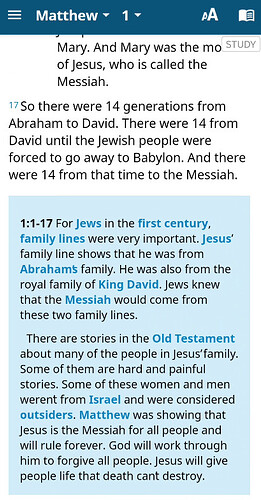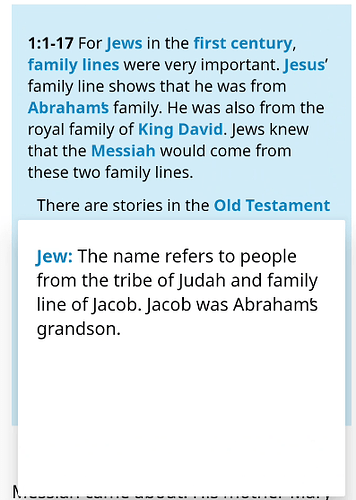Good day all,
I wanted to share how Biblica is doing their Study Bible, yet to be released.
The study material is shown after a section of verses and usually have about 2 sections of Study Notes within a chapter.
Regarding Q1, these notes would need to be converted into USFM format if you want it to display within scripture. If that is not required, you could import the file to Scripture App Builder to be used in another tab (there is a section in the help guide “building apps” regarding tabs).
In Paratext, we use \im or \imi for the tagging of the Study notes for Scripture App Builder to understand it.
Within Scripture App Builder, under the book section, you would need to play around with the setting to see what can work for your material.
Below is a snippet from Matthew 1 showing notes for verses 1-17.
\v 17 So there were 14 generations from Abraham to David. There were 14 from David until the Jewish people were forced to go away to Babylon. And there were 14 from that time to the Messiah.
\p
\im \bd 1:1–17\bd* For \k Jews\k*\ef - \fr 1:1–17 \fk Jew: \ft The name refers to people from the tribe of Judah and family line of Jacob. Jacob was Abrahamʼs grandson.\ef* in the \k first century\k*\ef - \fr 1:1–17 \fk First century: \ft The first hundred years in what many people call the AD time period. It comes right after the BC time period. Jesus lived in Israel then, around the time of 4 BC to AD 30. The Roman government ruled over Israel and many other nations during the first century.\ef*, \k family lines\k*\ef - \fr 1:1–17 \fk Family lines: \ft A written list of all the people in a family. These lists were very important in the ancient world. They are also called genealogies. It showed the history of a family line.\ef* were very important. \k Jesus\k*\ef - \fr 1:1–17 \fk Jesus: \ft The human being who is Godʼs Son and is the Saviour of the world. Jesus is God just like the Father is God and the Holy Spirit is God. They are the three persons of the one and only God. In the Hebrew language, Jesus means the Lord saves. When he lived on earth, Jesusʼs mother was Mary. Joseph was the human father who raised Jesus when he was young. Jesus grew up in Nazareth with brothers and sisters. He died and then God raised him from the dead. Now Jesus rules as King in heaven. He will return to earth to rule as King over everything God created.\ef*ʼ family line shows that he was from \k Abrahamʼs\k*\ef - \fr 1:1–17 \fk Abraham: \ft A man from Mesopotamia who became the father of the nation of Israel. He believed Godʼs promise that he would have a son. He was married to Sarah, and their son was named Isaac. God made a covenant with Abraham and all his children. Abraham had a second son named Ishmael.\ef* family. He was also from the royal family of \k King David\k*\ef - \fr 1:1–17 \fk King David: \ft The son of Jesse. David was a shepherd when he was young. He later became Israelʼs most famous king. His great-grandmother was Ruth, from Moab. He played instruments and wrote songs and poems. God made a covenant with David that someone from his family line would rule Israel for ever. The one who would fulfil that covenant is Jesus Christ. (See \w Son of David\w* \xt Matthew 9:18-38\xt* )\ef*. Jews knew that the \k Messiah\k*\ef - \fr 1:1–17 \fk Messiah: \ft The Saviour who would rescue the Jews from all their enemies. This true king would rule fairly. He would bring peace. He is also called the son of David.\ef* would come from these two family lines.
This will be displayed in the following way in the app:
The blue bolded words can be pressed and will display a popup:
Bolded words may not be required, so a simplfied version of the notes could be the following:
\im \bd 1:1–17\bd* For Jews in the first century, family lines were very important. Jesus’ family line shows that he was from Abraham’s family. He was also from the royal family of King David. Jews knew that the Messiah would come from these two family lines.
Please feel to reach out to me if you have any questions or need some reference files to play around with.
Kind regards,
James Cuthbert


